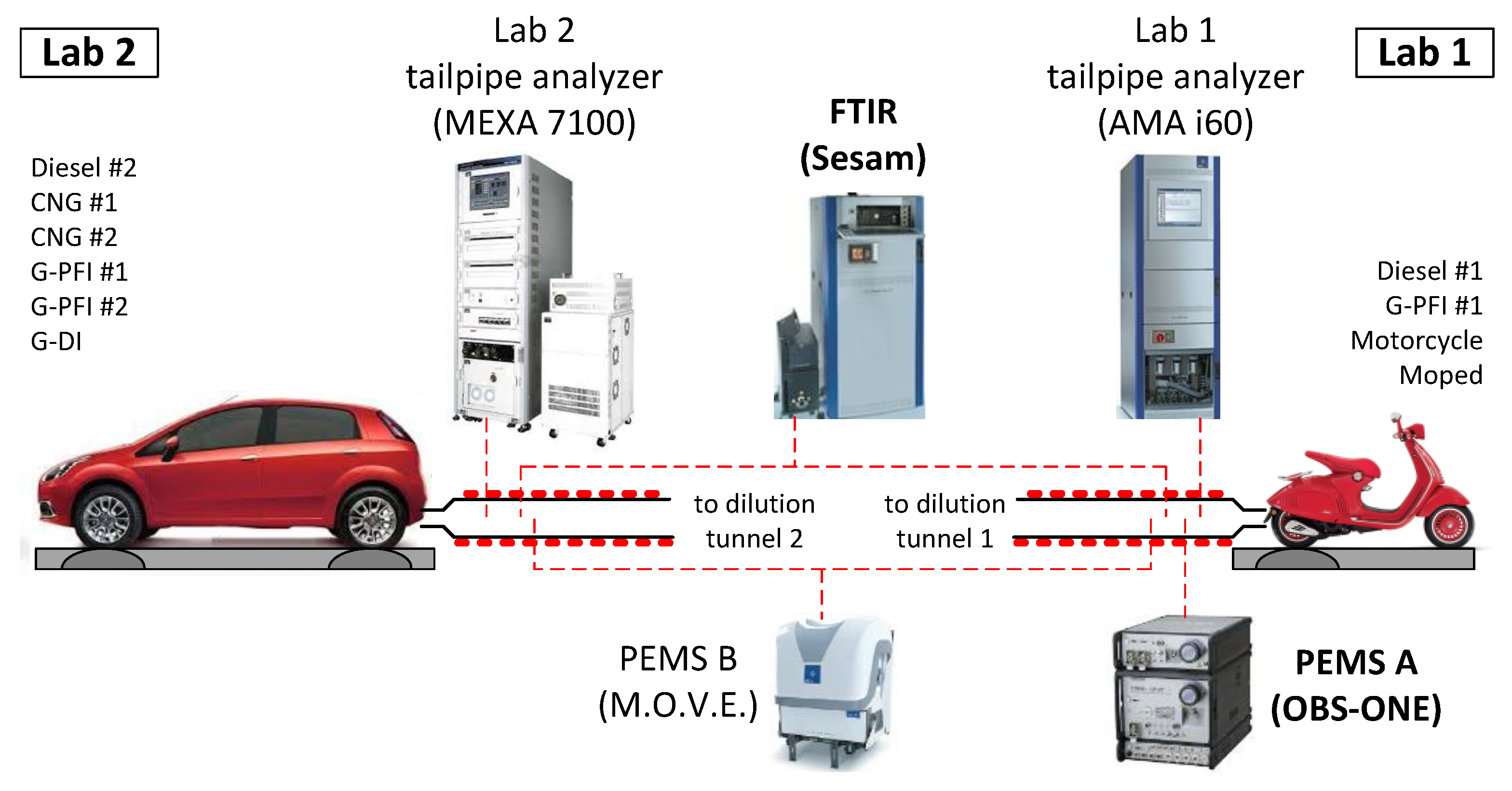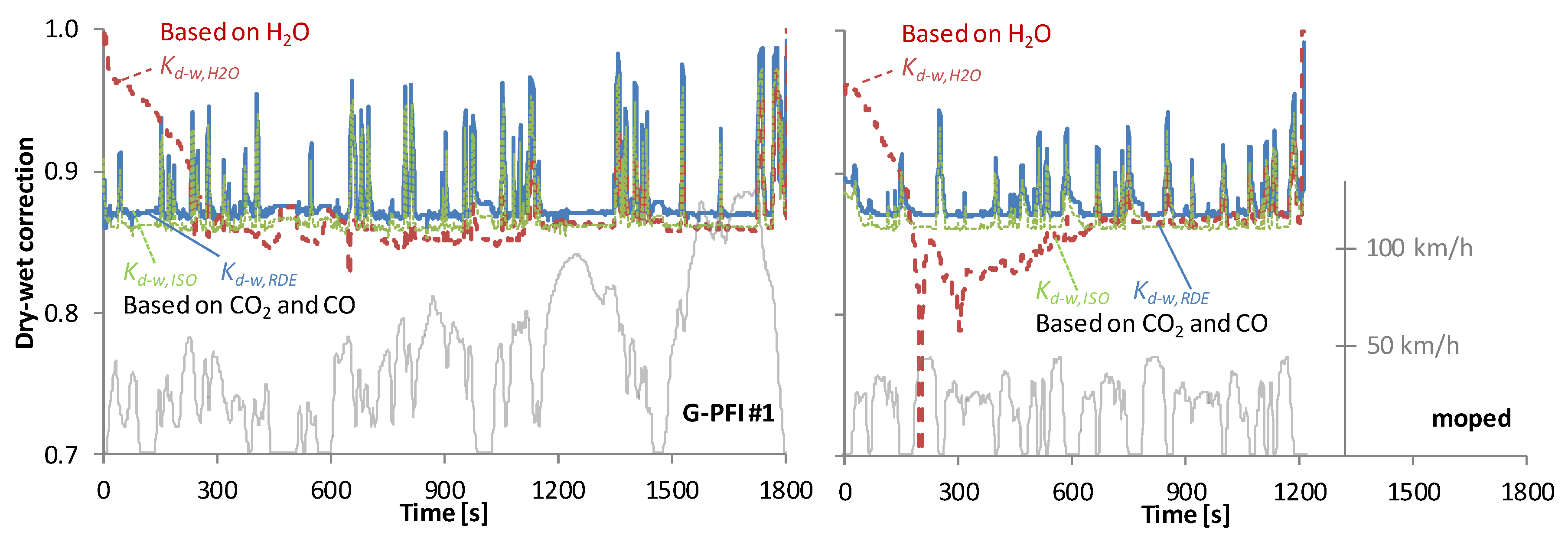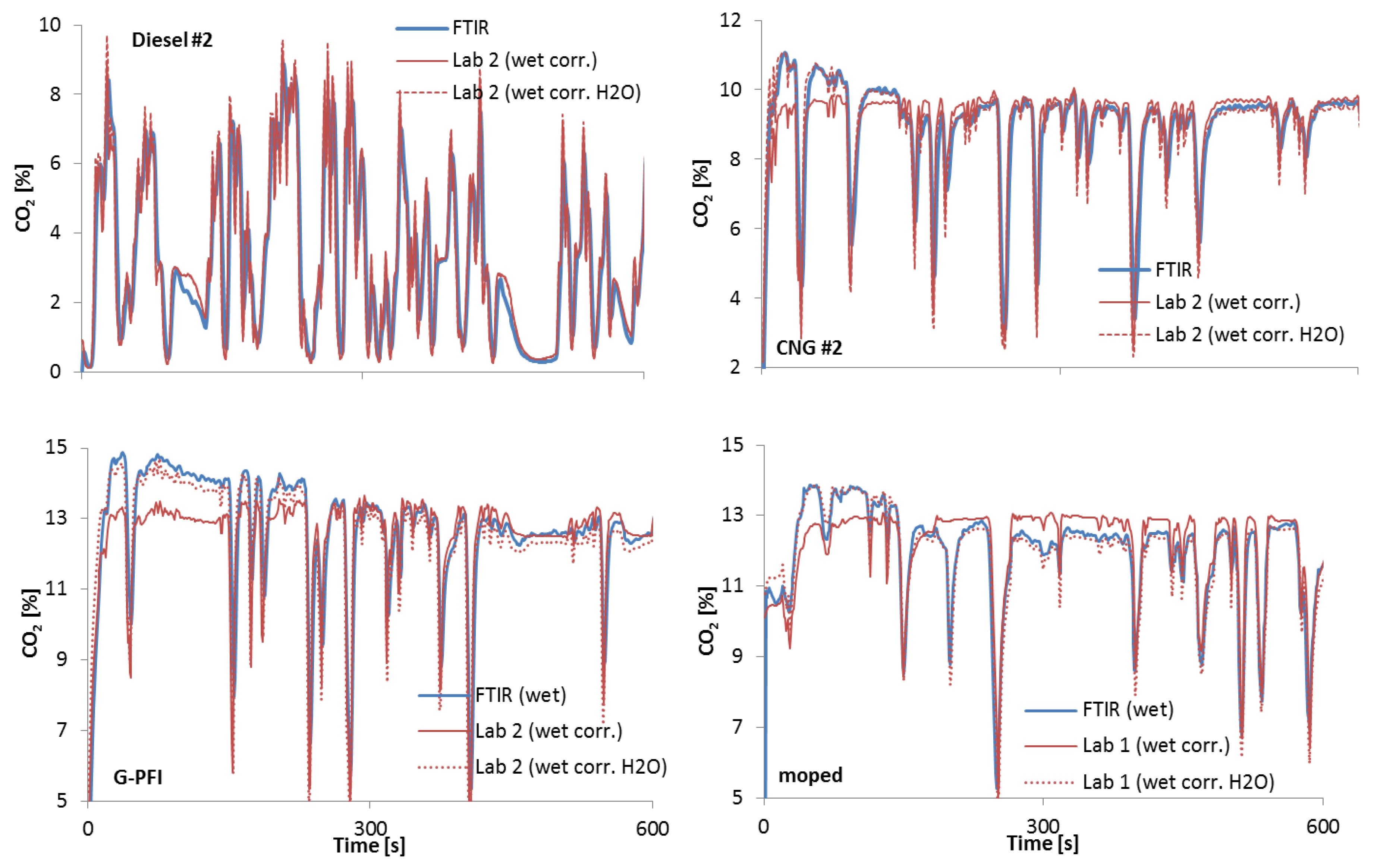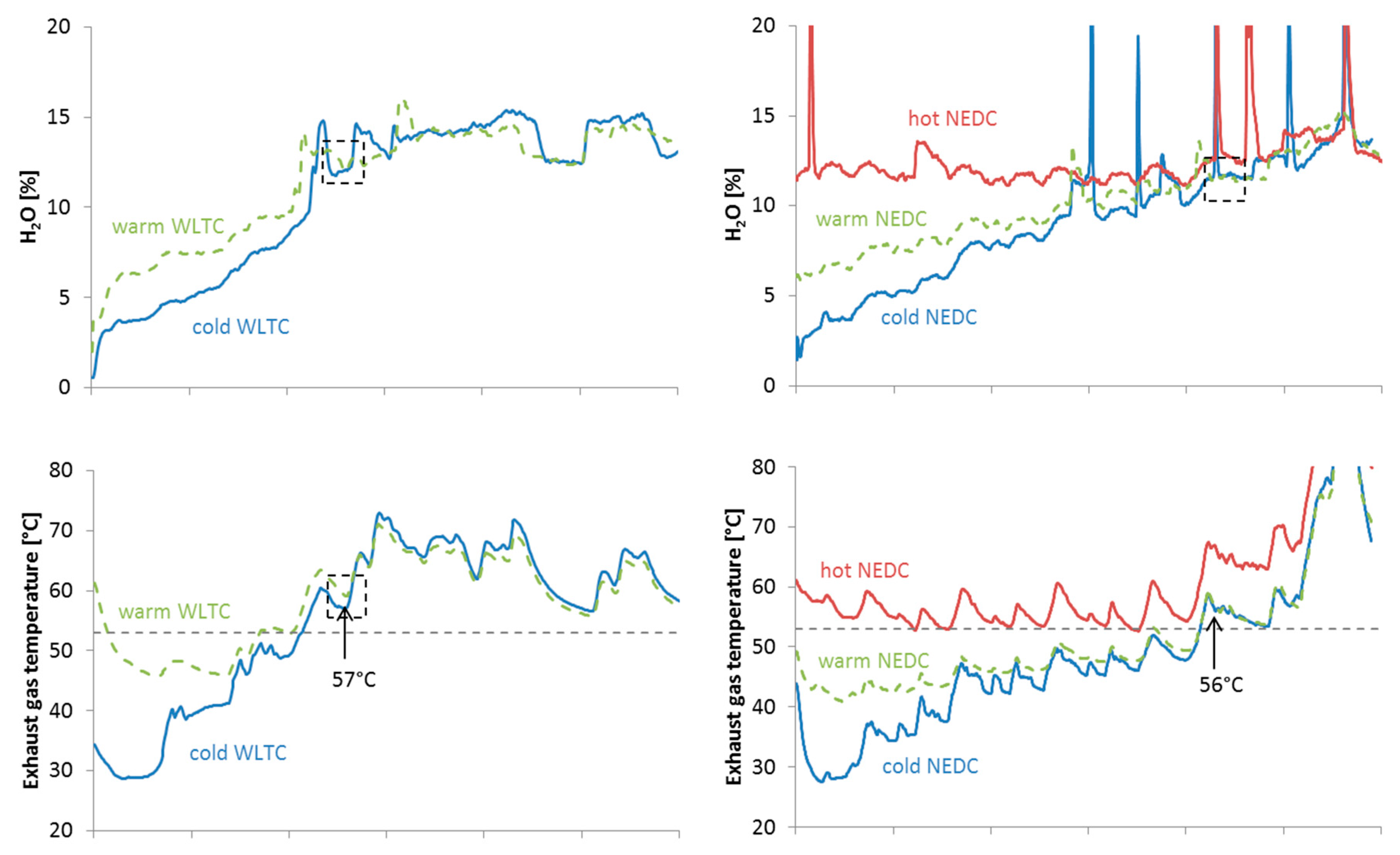Exhaust Gas Condensation during Engine Cold Start and Application of the Dry-Wet Correction Factor
Abstract
:Featured Application
Abstract
1. Introduction
2. Materials and Methods
3. Theoretical Analysis
3.1. RDE
3.2. ISO 8178
3.3. From H2O Measurements
3.4. CO2 Mass Emissions
4. Results
4.1. Dry-Wet Correction
4.2. CO2 Exhaust Measurements
4.3. Principle of Measurement
4.4. Exhaust Gas Temperature
5. Discussion
6. Implications and Outlook
- Cold start CO2 and CO emissions, either as absolute value or as contribution to total emissions can be underestimated.
- Comparisons of instrument measuring on dry- or wet-based methodology at the same location: this is the case, for example, of comparison of PEMS or FTIR systems with laboratory grade analyzers for gases that are measured with analyzers that have interference effects from water (CO2 and CO).
- Comparison of instruments at different sampling locations: differences can be observed due to condensation between the two locations. This is the case of tailpipe versus dilution tunnel with constant volume sampling (CVS) sampling.
- Comparison (validation) of PEMS with bags measurement if done in phases (at the moment the comparison is done for the complete cycle).
- Comparisons of different test cycles with the same instrument. The condensation takes place until the tailpipe and aftertreatment devices reach the dew point. However, this depends on the test parameters. As an example, the WLTC needed 250 s, while the NEDC 850 s to reach the dew point at the exit of the tailpipe.
- Comparisons of tests with different ambient relative humidity, because the amount of stored water in the aftertreatment devices could be different. For example, porous, honeycomb ceramic substrates such as those commonly used in diesel and gasoline particulate filters can store water at relatively high levels (up to 100 g/L under worst case conditions at 85 °C and 85% relative humidity) [43].
- Estimation of exhaust flow rate based on CO2 (or CO) measurements (e.g., the tracer method) or fuel consumption and air-to-fuel ratio.
7. Conclusions
Author Contributions
Acknowledgments
Conflicts of Interest
Abbreviations
| CNG | Compressed Natural Gas |
| CVS | Constant Volume Sampling |
| DI | Direct Injection |
| DOC | Diesel Oxidation Catalyst |
| DPF | Diesel Particulate Filter |
| EF | Emission Factor |
| EGR | Exhaust Gas Recirculation |
| EU | European Union |
| FTIR | Fourier-Transform Infrared Spectroscopy |
| G | Gasoline |
| G-DI | Gasoline Direct Injection |
| G-PFI | Gasoline Port Fuel Injection |
| IR | InfraRed |
| ISO | International Organization for Standardization |
| MY | Model Year |
| NDIR | Non-Dispersive Infrared Detection |
| NEDC | New European Driving Cycle |
| PEMS | Portable Emissions Measurement System |
| PFI | Port Fuel Injection |
| RDE | Real Driving Emissions |
| SCR | Selective Catalytic Reduction for NOx |
| SEMS | Simplified onboard Emissions Monitoring Systems |
| TWC | Three-way Catalytic Converter |
| VELA | Vehicle Emissions LAboratory |
| WLTC | Worldwide harmonized Light-duty vehicles Test Cycle |
| WMTC | Worldwide harmonized Motorcycle Test Cycle |
References
- European Environmental Energy. Air Quality in Europe—2018 Report; EEA Report No. 12/2018; Publication Office of the European Union: Luxembourg, 2018. [Google Scholar] [CrossRef]
- European Commission. Regulation (EU) No 333/2014 of the European Parliament and of the Council of 11 March 2014 amending Regulation (EC) No 443/2009 to define the modalities for reaching the 2020 target to reduce CO2 emissions from new passenger cars. Off. J. Eur. Union 2014, L103, 15–21. [Google Scholar]
- UNECE. Uniform Provisions Concerning the Measures to Be Taken against the Emission of Gaseous and Particulate Pollutants from Compression Ignition Engines and Positive Ignition Engines for Use in Vehicles; Regulation No. 49. Revision 6; United Nations Economic Commission for Europe: Geneva, Switzerland, 2013. [Google Scholar]
- Clairotte, M.; Adam, T.W.; Zardini, A.A.; Manfredi, U.; Martini, G.; Krasenbrink, A.; Vicet, A.; Tournié, E.; Astorga, C. Effects of low temperature on the cold start gaseous emissions from light duty vehicles fuelled by ethanol-blended gasoline. Appl. Energy 2013, 102, 44–54. [Google Scholar] [CrossRef]
- Code of Federal Regulations. Title 40: Protection of Environment. Part 1065—Engine-Testing Procedures. Subpart J—Field Testing and Portable Emission Measurement Systems. Available online: https://www.ecfr.gov/cgi-bin/text-idx?SID=6aca586aebc6de74a06dea2a85f5a5ab&mc=true&node=sp40.37.1065.j&rgn=div6 (accessed on 8 May 2019).
- European Commission. Commission Regulation (EU) No 582/2011 of 25 May 2011 implementing and amending Regulation (EC) No 595/2009 of the European Parliament and of the Council with respect to emissions from heavy-duty vehicles (Euro VI) and amending Annexes I and III to Directive 2007/46/EC of the European Parliament and of the Council. Off. J. Eur. Union 2011, L167, 1–168. [Google Scholar]
- European Commission. Commission Regulation (EU) 2016/427 of 10 March 2016 amending Regulation (EC) No 692/2008 as regards emissions from light passenger and commercial vehicles (Euro 6). Off. J. Eur. Union 2016, L82, 1–98. [Google Scholar]
- Adachi, M. Emission measurement techniques for advanced powertrains. Meas. Sci. Technol. 2000, 11, R113–R129. [Google Scholar] [CrossRef]
- Daham, B.; Andrews, G.; Li, H.; Ballesteros, R.; Bell, M.; Tate, J.; Ropkins, K. Application of a portable FTIR measuring on-road emissions. SAE Tech. Pap. 2005, 20, 171–192. [Google Scholar] [CrossRef]
- Zardini, A.A.; Suarez-Bertoa, R. Unregulated pollutants from tampered two-wheelers. Transp. Res. Procedia 2016, 14, 3109–3118. [Google Scholar] [CrossRef]
- Clairotte, M.; Adam, T.W.; Chirico, R.; Giechaskiel, B.; Manfredi, U.; Elsasser, M.; Sklorz, M.; De Carlo, P.F.; Heringa, M.F.; Zimmermann, R.; et al. Online characterization of regulated and unregulated gaseous and particulate exhaust emissions from two-stroke mopeds: A chemometric approach. Anal. Chim. Acta 2012, 717, 28–38. [Google Scholar] [CrossRef]
- ISO 8178-1:2017. Reciprocating Internal Combustion Engines—Exhaust Emission Measurement— Part 1: Test-Bed Measurement Systems of Gaseous and Particulate Emissions; ISO: Geneva, Switzerland, 2017. [Google Scholar]
- Silvis, W. An algorithm for calculating the air/fuel ratio from exhaust emissions. SAE Tech. Pap. 1997, 970514. [Google Scholar] [CrossRef]
- D’Ambrosio, S.; Spessa, E.; Vassallo, A. Methods for specific emission evaluation in spark ignition engines based on calculation procedures of air-fuel ratio: Development, assessment, and critical comparison. J. Eng. Gas Turbines Power 2005, 127, 869–882. [Google Scholar] [CrossRef]
- Garrido Gonzalez, N.; Baar, R.; Drueckhammer, J.; Kaeppner, C. The thermodynamics of exhaust gas condensation. SAE Tech. Pap. 2017, 10, 1411–1421. [Google Scholar] [CrossRef]
- Yang, B.; Mao, S.; Altin, O.; Feng, Z.; Michaelides, E. Condensation analysis of exhaust gas recirculation system for heavy-duty trucks. J. Therm. Sci. Eng. Appl. 2011, 3, 041007. [Google Scholar] [CrossRef]
- Sharma, M.; Laing, P.; Son, S. Modeling water condensation in exhaust A/T devices. SAE Tech. Pap. 2010, 2010-01-0885. [Google Scholar] [CrossRef]
- Barros, S.; Atkinson, W.; Piduru, N. Extraction of liquid water from the exhaust of a diesel engine. SAE Tech. Pap. 2015, 2015-01-2806. [Google Scholar] [CrossRef]
- Inoue, K.; Ishihara, M.; Akashi, K.; Adachi, M.; Ishida, K. Numerical analysis of mass emission measurement systems at low emission vehicles. SAE Tech. Pap. 1999, 1999-01-0150. [Google Scholar] [CrossRef]
- Meena, R.; Krusch, A.; Meister, K.; Holzknecht, C. Water load determination approach in two wheeler exhaust system. SAE Tech. Pap. 2018, 2018-32-0075. [Google Scholar] [CrossRef]
- Mohn, J.; Forss, A.-M.; Brühlmann, S.; Zeyer, K.; Lüscher, R.; Emmenegger, L.; Novak, P.; Heeb, N. Time-resolved ammonia measurement in vehicle exhaust. Int. J. Environ. Pollut. 2004, 22, 342–356. [Google Scholar] [CrossRef]
- Weilenmann, M.; Soltic, P.; Saxer, C.; Forss, A.; Heeb, N. Regulated and nonregulated diesel and gasoline cold start emissions at different temperatures. Atmos. Environ. 2005, 39, 2433–2441. [Google Scholar] [CrossRef]
- Weilenmann, M.; Favez, J.-Y.; Alvarez, R. Cold-start emissions of modern passenger cars at different low ambient temperatures and their evolution over vehicle legislation categories. Atmos. Environ. 2009, 43, 2419–2429. [Google Scholar] [CrossRef]
- Favez, J.-Y.; Weilenmann, M.; Stilli, J. Cold start extra emissions as a function of engine stop time: Evolution over the last 10 years. Atmos. Environ. 2009, 43, 996–1007. [Google Scholar] [CrossRef]
- Zardini, A.A.; Platt, S.M.; Clairotte, M.; El Haddad, I.; Temime-Roussel, B.; Marchand, N.; Ježek, I.; Drinovec, L.; Močnik, G.; Slowik, J.G.; et al. Effects of alkylate fuel on exhaust emissions and secondary aerosol formation of a 2-stroke and a 4-stroke scooter. Atmos. Environ. 2014, 94, 307–315. [Google Scholar] [CrossRef]
- Ko, J.; Son, J.; Myung, C.; Park, S. Comparative study on low ambient temperature regulated/unregulated emissions characteristics of idling light-duty diesel vehicles at cold start and hot restart. Fuel 2018, 233, 620–631. [Google Scholar] [CrossRef]
- Li, H.; Andrews, G.; Savvidis, D.; Daham, B.; Ropkins, K.; Bell, M.; Tate, J. Characterization of regulated and unregulated cold start emissions for different real world urban driving cycles using a SI passenger car. SAE Tech. Pap. 2008, 2008-01-1648. [Google Scholar] [CrossRef]
- Khalfan, A.; Li, H.; Andrews, G. Cold Start SI Passenger Car Emissions from Real World Urban Congested Traffic. SAE Tech. Pap. 2015, 2015-01-1064. [Google Scholar] [CrossRef]
- Giechaskiel, B. Solid particle number emission factors of Euro VI heavy-duty vehicles on the road and in the laboratory. Int. J. Environ. Res. Public Health 2018, 15, 304. [Google Scholar] [CrossRef] [PubMed]
- Giechaskiel, B.; Gioria, R.; Carriero, M.; Lähde, T.; Forloni, F.; Perujo, A.; Martini, G.; Bissi, L.M.; Terenghi, R. Emission factors of a Euro VI heavy-duty diesel refuse collection vehicle. Sustainability 2019, 11, 1067. [Google Scholar] [CrossRef]
- Giechaskiel, B.; Suarez-Bertoa, R.; Lahde, T.; Clairotte, M.; Carriero, M.; Bonnel, P.; Maggiore, M. Emissions of a Euro 6b diesel passenger car retrofitted with a solid ammonia reduction system. Atmosphere 2019, 10, 180. [Google Scholar] [CrossRef]
- Varella, R.; Giechaskiel, B.; Sousa, L.; Duarte, G. Comparison of portable emissions measurement systems (PEMS) with laboratory grade equipment. Appl. Sci. 2018, 8, 1633. [Google Scholar] [CrossRef]
- Giechaskiel, B.; Casadei, S.; Mazzini, M.; Sammarco, M.; Montabone, G.; Tonelli, R.; Deana, M.; Costi, G.; Di Tanno, F.; Prati, M.V.; et al. Inter-laboratory correlation exercise with portable emissions measurement systems (PEMS) on chassis dynamometers. Appl. Sci. 2018, 8, 2275. [Google Scholar] [CrossRef]
- European Commission. Regulation (EC) No 715/2007 of the European Parliament and of the Council of 20 June 2007 on type approval of motor vehicles with respect to emissions from light passenger and commercial vehicles (Euro 5 and Euro 6) and on access to vehicle repair and maintenance information. Off. J. Eur. Union 2007, L171, 1–16. [Google Scholar]
- European Commission. Regulation (EU) No 168/2013 of the European parliament and of the council of 15 January 2013 on the approval and market surveillance of two- or three-wheel vehicles and quadricycles. Off. J. Eur. Union 2013, L60, 52–128. [Google Scholar]
- Ohtsuki, S.; Inoue, K.; Yamagishi, Y.; Namiyama, K. Studies on emission measurement techniques for super-ultra low emission vehicles. SAE Tech. Pap. 2002, 2002-01-2709. [Google Scholar] [CrossRef]
- Ropkins, K.; Tate, J.; Li, H.; Andrews, G.; Hawley, G.; Bell, M. Chassis dynamometer evaluation of on-board exhaust emission measurement system performance in SI car under transient operating conditions. SAE Tech. Pap. 2008, 2008-01-1826. [Google Scholar] [CrossRef]
- Clairotte, M.; Valverde, V.; Bonnel, P.; Giechaskiel, B.; Carriero, M.; Otura, M.; Fontaras, G.; Pavlovic, J.; Martini, G.; Krasenbrink, A.; et al. Joint Research Centre 2017 Light-Duty Vehicles Emissions Testing; EUR 29302EN; Publications Office of the European Union: Luxembourg, 2018. [Google Scholar]
- Valverde, V.; Adria, B.; Clairotte, M.; Pavlovic, J.; Suarez-Bertoa, R.; Giechaskiel, B.; Astoga-Llorens, C.; Fontaras, G. Emission factors derived from thirteen Euro 6b light-duty vehicles based on laboratory and on-road measurements. Atmosphere 2019, 10, 243. [Google Scholar] [CrossRef]
- Suarez-Bertoa, R.; Astorga, C. Impact of cold temperature on Euro 6 passenger car emissions. Environ. Pollut. 2018, 234, 318–329. [Google Scholar] [CrossRef]
- Heepen, F.; Yu, W. SEMS for individual trip reports and long-time measurement. SAE Tech. Pap. 2019, 2019-01-0752. [Google Scholar] [CrossRef]
- Varella, R.; Duarte, G.; Baptista, P.; Sousa, L.; Mendoza Villafuerte, P. Analysis of the influence of outdoor temperature in vehicle cold-start operation following EU real driving emission test procedure. SAE Int. J. Commer. Veh. 2017, 10, 596–697. [Google Scholar] [CrossRef]
- Sappok, A.; Ragaller, P.; Guarino, A.; Mandelbaum, J.; Lapenta, L.; Kolberg, D.; Newman, R.; Lu, X.; Cors, D. Direct measurement of aftertreatment system stored water levels for improved dew point management using radio frequency sensing. SAE Tech. Pap. 2019, 2019-01-0739. [Google Scholar] [CrossRef]








| Code | Euro (-) | MY (-) | Fuel (-) | Mass (kg) | Power (kW) | Displ. (l) | Aftertreatment (-) |
|---|---|---|---|---|---|---|---|
| Diesel #1 | 6b | 2017 | B7 | 1360 | 90 | 1.6 | DOC + DPF |
| Diesel #2 | 6d-temp | 2018 | B7 | 1180 | 96 | 1.5 | DOC + DPF + SCR |
| CNG #1 | 6c | 2018 | CNG | 1360 | 80 | 1.0 | TWC |
| CNG #2 | 6b | 2018 | CNG | 2310 | 100 | 3.0 | TWC |
| G-PFI #1 | 6b | 2014 | E10 | 1130 | 57 | 1.4 | TWC |
| G-PFI #2 | 6d-temp | 2018 | E10 | 1200 | 60 | 1.2 | TWC |
| G-DI #1 | 6c | 2017 | E10 | 1390 | 110 | 1.5 | TWC |
| Motorcycle | 4 | 2018 | E10 | 150 | 16 | 0.28 | TWC |
| Moped | 4 | 2018 | E10 | 95 | 2.5 | 0.05 | TWC |
| Parameter | PEMS A | PEMS B | Lab 1 | Lab 2 | FTIR |
|---|---|---|---|---|---|
| Manufacturer | Horiba | AVL | AVL | Horiba | AVL |
| Model | OBS-ONE | M.O.V.E. | AMA i60 | MEXA 7100 | Sesam |
| Principle CO2 | Heated NDIR | NDIR | NDIR | NDIR | FTIR |
| Measurement | wet | dry | dry | dry | wet |
| Max CO2 | 20% | 20% | 20% | 20% | 20% |
| Calibration gas | 15% | 15% | 15% | 15% | - |
| Sampling line | 90 °C | 90 °C | 190 °C | 190 °C | 190 °C |
| Vehicle | Start Time (s) | Start Kd-w,H2O | Start Kd-w,RDE | Dev (%) | Rest Kd-w,H2O | Rest Kd-w,RDE | Dev (%) |
|---|---|---|---|---|---|---|---|
| Diesel #1 | 35 | 0.99 | 0.94 | −5.0% | 0.94 | 0.95 | +0.9% |
| Diesel #2 | 45 | 0.99 | 0.96 | −3.7% | 0.94 | 0.95 | +1.0% |
| CNG #1 | 200 | 0.93 | 0.82 | −12.0% | 0.80 | 0.82 | +3.1% |
| CNG #2 | 135 | 0.88 | 0.82 | −7.1% | 0.80 | 0.82 | +1.9% |
| G-PFI #1 | 230 | 0.94 | 0.87 | −7.6% | 0.86 | 0.88 | +2.0% |
| G-PFI #2 | 160 | 0.95 | 0.88 | −7.4% | 0.87 | 0.89 | +2.3% |
| G-DI | 600 | 0.92 | 0.88 | −4.6% | 0.85 | 0.87 | +2.6% |
| Motorcycle | 100 | 0.92 | 0.87 | −5.2% | 0.86 | 0.87 | +1.5% |
| Moped | 140 | 0.94 | 0.88 | −6.0% | 0.86 | 0.88 | +2.7% |
| Vehicle | Start Time (s) | FTIR Start CO2 (%) | Lab with Kd-w,RDE | Lab with Kd-w,H2O | FTIR Rest CO2 (%) | Lab with Kd-w,RDE | Lab with Kd-w,H2O |
|---|---|---|---|---|---|---|---|
| Diesel #1 | 35 | 5.53 | −8.4% | −2.0% | 4.85 | −1.4% | −1.8% |
| Diesel #2 | 45 | 3.79 | −5.4% | +0.4% | 5.00 | −0.3% | −0.5% |
| CNG #1 | 200 | 10.01 | −9.7% | −0.5% | 9.02 | −1.2% | −0.1% |
| CNG #2 | 135 | 9.38 | −6.3% | −1.5% | 9.01 | +0.3% | +3.0% |
| G-PFI #1 | 230 | 13.04 | −5.3% | −0.2% | 12.05 | −0.2% | −1.4% |
| G-PFI #2 | 160 | 13.31 | −7.3% | +0.6% | 11.79 | +0.7% | −1.5% |
| G-DI | 600 | 13.22 | −9.3% | −1.0% | 12.77 | −1.2% | −2.2% |
| Motorcycle | 100 | 13.11 | −6.6% | −0.7% | 12.97 | −1.7% | −1.0% |
| Moped | 140 | 12.57 | −4.6% | +1.9% | 11.84 | +1.8% | +1.4% |
| Vehicle | Start Time | ΔCO2 | Start CO2 | Effect | Total CO2 | Effect | EFCO2 |
|---|---|---|---|---|---|---|---|
| (s) | (g) | (g) | (g) | (g/km) | |||
| Diesel #1 | 35 | −2.7 | 49 | −5.6% | 3374 | −0.1% | 144.8 |
| Diesel #2 | 45 | −2.8 | 46 | −6.0% | 2760 | −0.1% | 118.5 |
| CNG #1 | 200 | −24.8 | 195 | −12.7% | 2842 | −0.9% | 122.0 |
| CNG #2 | 135 | −40.9 | 455 | −9.0% | 6819 | −0.6% | 292.7 |
| G-PFI #1 | 230 | −23.5 | 322 | −7.3% | 3669 | −0.6% | 157.5 |
| G-PFI #2 | 160 | −11.5 | 123 | −10.5% | 3250 | −0.4% | 139.5 |
| G-DI | 600 | −26.8 | 318 | −8.4% | 3096 | −0.9% | 132.9 |
| Motorcycle | 100 | −3.2 | 70 | −4.5% | 1058 | −0.3% | 80.8 |
| Moped | 140 | −3.1 | 53 | −5.9% | 451 | −0.7% | 59.3 |
| Vehicle | Start Time | ΔCO | Start CO | Effect | Total CO | Effect | EFCO |
|---|---|---|---|---|---|---|---|
| (s) | (mg) | (mg) | (mg) | (mg/km) | |||
| Diesel #1 | 35 | 29 | 511 | −5.7% | 884 | −3.3% | 38 |
| Diesel #2 | 45 | 12 | 261 | −4.7% | 1253 | −1.0% | 54 |
| CNG #1 | 200 | 798 | 6195 | −12.9% | 11,700 | −6.8% | 502 |
| CNG #2 | 135 | 195 | 1467 | −13.3% | 1971 | −9.9% | 85 |
| G-PFI #1 | 230 | 510 | 4354 | −11.7% | 16,204 | −3.1% | 695 |
| G-PFI #2 | 160 | 145 | 1844 | −7.9% | 2914 | −5.0% | 125 |
| G-DI | 600 | 102 | 1076 | −9.5% | 2172 | −4.7% | 93 |
| Motorcycle | 100 | 113 | 1696 | −6.7% | 8336 | −1.4% | 636 |
| Moped | 140 | 85 | 1319 | −6.4% | 6805 | −1.2% | 895 |
© 2019 by the authors. Licensee MDPI, Basel, Switzerland. This article is an open access article distributed under the terms and conditions of the Creative Commons Attribution (CC BY) license (http://creativecommons.org/licenses/by/4.0/).
Share and Cite
Giechaskiel, B.; Zardini, A.A.; Clairotte, M. Exhaust Gas Condensation during Engine Cold Start and Application of the Dry-Wet Correction Factor. Appl. Sci. 2019, 9, 2263. https://doi.org/10.3390/app9112263
Giechaskiel B, Zardini AA, Clairotte M. Exhaust Gas Condensation during Engine Cold Start and Application of the Dry-Wet Correction Factor. Applied Sciences. 2019; 9(11):2263. https://doi.org/10.3390/app9112263
Chicago/Turabian StyleGiechaskiel, Barouch, Alessandro A. Zardini, and Michael Clairotte. 2019. "Exhaust Gas Condensation during Engine Cold Start and Application of the Dry-Wet Correction Factor" Applied Sciences 9, no. 11: 2263. https://doi.org/10.3390/app9112263
APA StyleGiechaskiel, B., Zardini, A. A., & Clairotte, M. (2019). Exhaust Gas Condensation during Engine Cold Start and Application of the Dry-Wet Correction Factor. Applied Sciences, 9(11), 2263. https://doi.org/10.3390/app9112263




